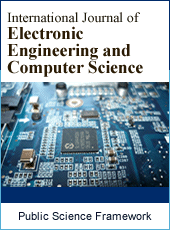International Journal of Electronic Engineering and Computer Science
Articles Information
International Journal of Electronic Engineering and Computer Science, Vol.3, No.1, Feb. 2018, Pub. Date: Jan. 16, 2018
Improvement of Correlation Identification Method Based on Non-Negative Periodic Autocorrelation Function
Pages: 1-5 Views: 2304 Downloads: 551
[01]
Ren Rui, School of Information Engineering, China University of Geosciences (Beijing), Beijing, China.
[02]
Cao Jian-peng, School of Information Engineering, China University of Geosciences (Beijing), Beijing, China.
[03]
Zhang Qiao-dan, School of Information Engineering, China University of Geosciences (Beijing), Beijing, China.
[04]
Li Mei, School of Information Engineering, China University of Geosciences (Beijing), Beijing, China.
The correlation identification algorithm is a system identification method that can effectively suppress stochastic noise. However, since the auto spectrum of m-sequence has zero amplitude points, it will seriously affect the result of identification. Based on this problem, this paper proposes advanced method: we only take the non-negative part of the autocorrelation function and the cross correlation function, the spectrum of non-negative period autocorrelation function does not exist zero points. Compared with the auto spectrum of m sequence, the spectrum of non-negative period autocorrelation function has obvious advantages. In order to solve the conventional zero problem and improve the identification accuracy, this paper uses this method. Experiments showed that the improved correlation identification method had a higher identification accuracy and had achieved better identification results.
Correlation Identification, Autocorrelation Function, Non-negative Period, M-sequences
[01]
Li, M., Wei, W., Luo, W., Xu, Q. (2013). Time-Domain Spectral Induced Polarization Based on Pseudo-random Sequence. Pure and Applied Geophysics, 170 (12), 2257-2262.
[02]
Davidson, J. N., Stone, D. A., Foster, M. P., & Gladwin, D. T. (2014). Improved bandwidth and noise resilience in thermal impedance spectroscopy by mixing PRBS signals. IEEE Transactions on Power Electronics, 29 (9), 4817-4828.
[03]
LUO Pingan, MIAO Chang (1999). Deconvolution Theorem - Deconvolution of Spectrum with Zero Point [J]. Nuclear Electronics and Detection Technology, 19 (6): 454-459.
[04]
Shu Qin, Zhang Youzheng (1990). DFT Algorithm for Convolution Inversion of X [k] with Zero Point [J]. Journal of Electronics, (3): 83-89.
[05]
QIU Lishan (2017). Design of Electrical Law Transmitter System Based on Correlation Identification [D]. China University of Geosciences (Beijing).
[06]
Li Mei (2011). Research on Time Domain Spectral Excitation Based on Correlation Identification Technology [D]. Beijing: China University of Geosciences.
[07]
Li Bainan (2014). Pseudo-random signal and related identification [M]. Science Press, 1987.
[08]
Miao, B., Zane, R. E., Maksimovic, D. (2004). A modified cross-correlation method for system identification of power converters with digital control. Power Electronics Specialists, 3728-3733.
[09]
LI Mei, WEI Wenbo (2015), et al. Correlation-discriminative spectroscopic method [M]. Beijing: Geological Publishing House.
[10]
Chen Yudong (2014). Digital Signal Processing [M]. Geological Publishing House.

ISSN Print: Pending
ISSN Online: Pending
Current Issue:
Vol. 6, Issue 3, September Submit a Manuscript Join Editorial Board Join Reviewer Team
ISSN Online: Pending
Current Issue:
Vol. 6, Issue 3, September Submit a Manuscript Join Editorial Board Join Reviewer Team
| About This Journal |
| All Issues |
| Open Access |
| Indexing |
| Payment Information |
| Author Guidelines |
| Review Process |
| Publication Ethics |
| Editorial Board |
| Peer Reviewers |


